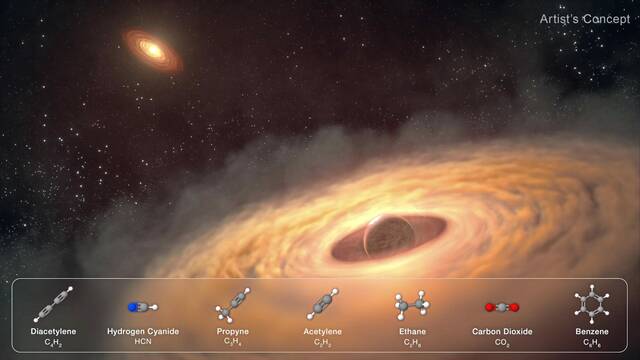Scientists have gotten a never-before-seen look at an area around a large exoplanet 625 light-years away where moons like the one orbiting Earth could potentially form.
Using data from NASA’s James Webb Space Telescope, a team of researchers were able to study the chemistry surrounding a world called CT Cha b. Though no moons have yet been detected in this particular cosmic region, the carbon-rich disk circling the planet is “a possible construction yard for moons,” NASA said in a blog post highlighting the discovery.
Because the disk and the material it’s accreting is not unlike what is theorized to have given birth to Jupiter’s four famous Galilean moons, the team suggested further study will help the world’s astronomers better understand planet and moon formation in our solar system and beyond into the Milky Way galaxy.
“Moons likely outnumber planets, and some might be habitats for life as we know it,” NASA said in the post. “But we are only now entering an era where we can witness their formation.”
Here’s everything to know about the discovery amid the ongoing search and study of exoplanets.
What are exoplanets?
Exoplanets are planets outside Earth’s solar system. For that reason, these celestial bodies are sometimes also referred to as extrasolar planets.
Some, called rogue planets, don’t even orbit a star, but rather are floating through the cosmos untethered.
As of Sept. 30, a total of 6,013 exoplanets have been confirmed, according to NASA’s Exoplanet Science Institute, which monitors and tracks exoplanets. What’s more, not only are nearly 8,000 additional exoplanet candidates awaiting official confirmation, but billions are thought to exist, astronomers say.
What is the exoplanet CT Cha b?
By studying data from the area around this particular exoplanet, CT Cha b, scientists were able to make the first-ever measurements of the chemical and physical properties of a potential moon-forming disk.
Webb’s Mid-Infrared Instrument (MIRI), which shows thermal light, collected observations of the planet that allowed the team to discover signs of molecules within an accumulation of matter out of which moons may form, known as a circumplanetary disk.
While the planet orbits a young 2 million-year-old star, the team was able to determine that the cirumplanetary disk is 46 billion miles away ‒ meaning it is not part of the star’s larger accretion disk. What’s more, the circumplanetary disk was found to have carbon-bearing molecules, a stark difference from the chemistry in the planet’s host star, which has water but no carbon, according to the researchers.
“We’re not just witnessing moon formation,” study co-lead author Sierra Grant, an astronomer with the Carnegie Institution for Science in Washington, said in a statement. “We’re also witnessing this planet’s formation.”
The research was published Sept. 29 in The Astrophysical Journal Letters.
What is the James Webb Space Telescope?
The James Webb Space Telescope launched on Christmas Day 2021 aboard an Ariane 5 rocket from the European Space Agency’s Ariane Space Spaceport in French Guiana.
Webb, which then began its cosmic operations in July 2022, was designed to operate for up to 10 years. But as fortune would have it, the mission team determined the observatory should have enough propellant to allow it to operate in orbit for more than 20 years.
Billed by NASA as “the largest, most powerful and most complex telescope ever launched into space,” the James Webb Space Telescope far surpasses the abilities of its predecessor, the Hubble Space Telescope. The observatory is named for NASA’s second-ever administrator.
Orbiting the sun rather than Earth, Webb is outfitted with a gold-coated mirror more than 21 feet in diameter and powerful infrared instruments to observe the cosmos like no instrument before.








